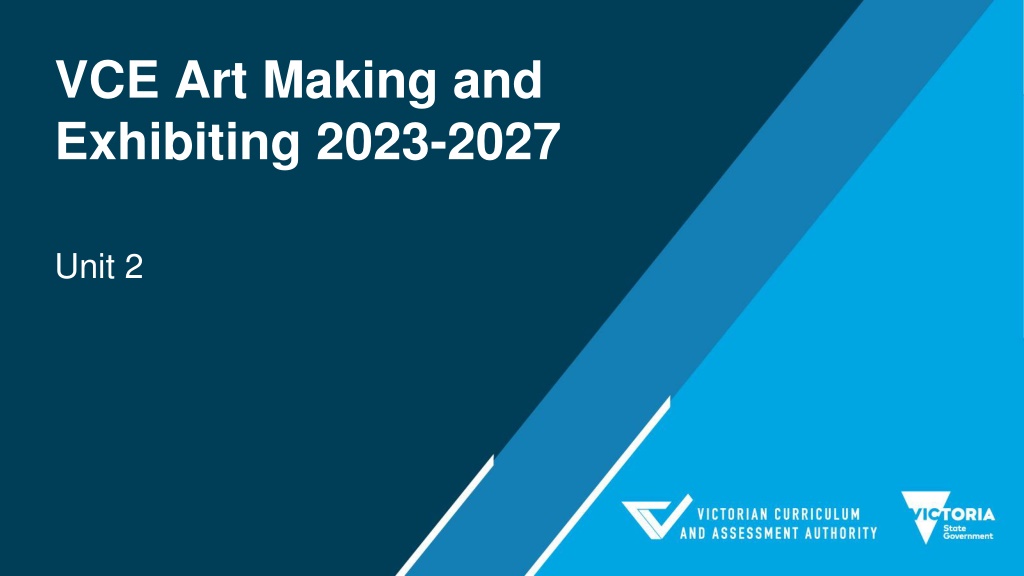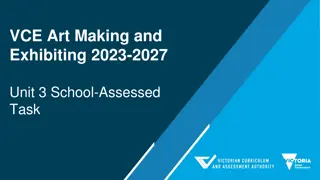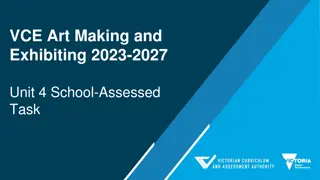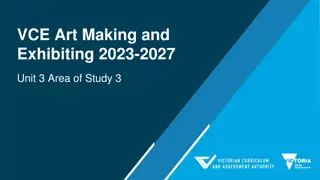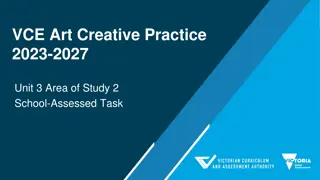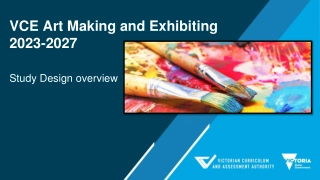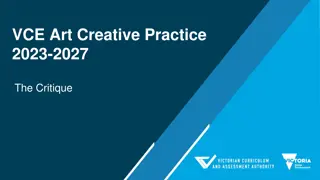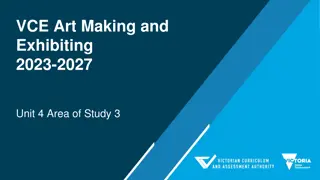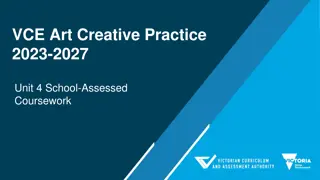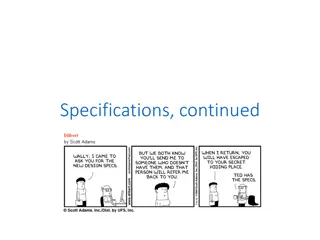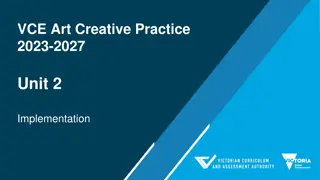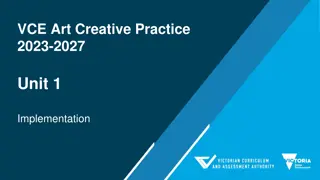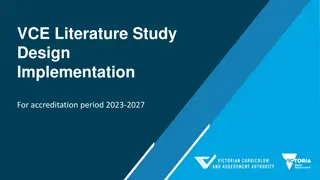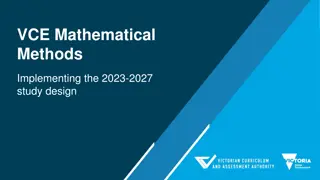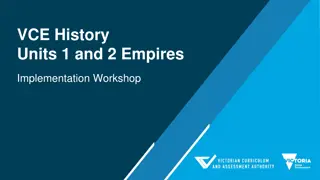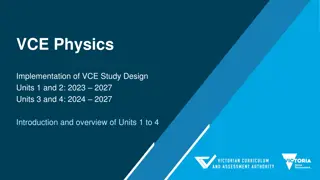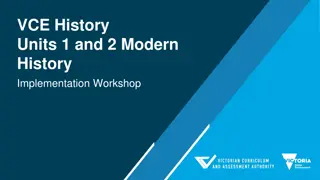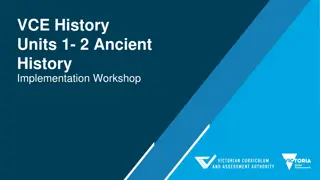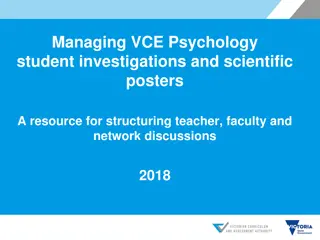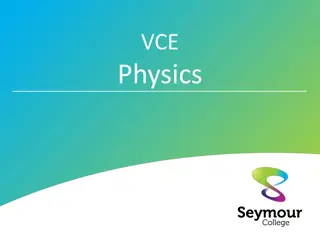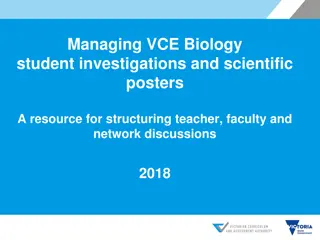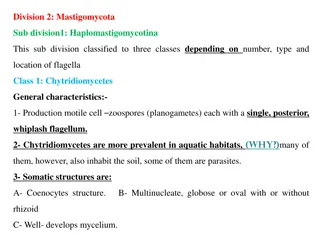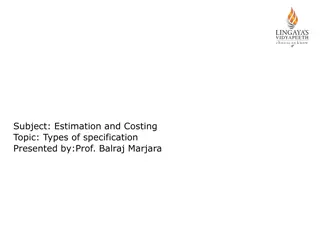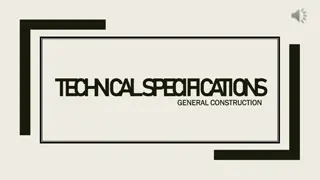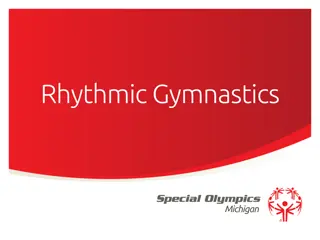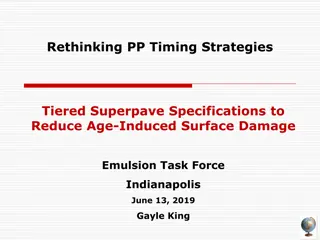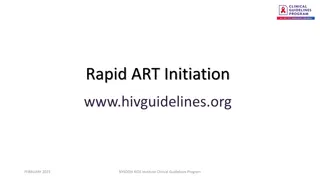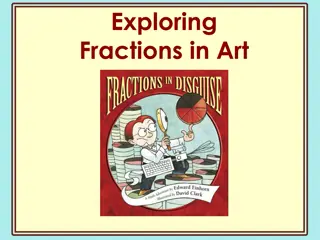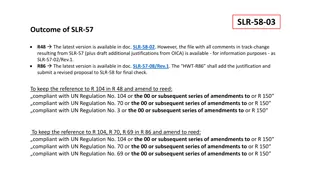VCE Art Making and Exhibiting Study Specifications
Explore, expand, investigate, understand, develop, and resolve art forms, techniques, ideas, processes, and aesthetic qualities in VCE Art Making and Exhibiting. Study specifications cover creating and exhibiting artworks, planning exhibitions, curation, and conservation in various art spaces.
Download Presentation

Please find below an Image/Link to download the presentation.
The content on the website is provided AS IS for your information and personal use only. It may not be sold, licensed, or shared on other websites without obtaining consent from the author. Download presentation by click this link. If you encounter any issues during the download, it is possible that the publisher has removed the file from their server.
E N D
Presentation Transcript
VCE Art Making and Exhibiting 2023-2027 Unit 2
VCE Art Making and Exhibiting Unit 2 Outline Features of Unit 2 Art Making and Exhibiting Overview of the areas of study Teaching ideas Assessment ideas
VCE Art Making and Exhibiting Study specifications Explore Expand Investigate Understand Develop Resolve Collect Extend Connect Consolidate Present Conserve
VCE Art Making and Exhibiting Study specifications: Making artworks Explore Expand Investigate Understand Develop Resolve Collect Extend Connect Consolidate Present Conserve Artforms Influences and inspiration Techniques Ideas and meaning Processes Making artworks Visual Language Materials Art elements and Art Principles Aesthetic qualities
VCE Art Making and Exhibiting Study specifications: Exhibiting artworks Planning and producing the layout and design of the exhibition and planning the flow of the exhibition, including sight lines, spatial relationships, viewer interaction and interpretation. Includes the creation of display furniture, selection of fixtures and use of lighting. Exhibition design Determining the theme or story to be told in an exhibition. Curation includes the selection of artworks, writing the introduction to the exhibition, deciding where artworks will be placed, the designing of viewer interaction and interpretation, and the preparation of condition reports of artworks. Curation Planning, organising and undertaking the preservation and conservation of materials and objects in private, public and community collections, including art galleries, museums, other exhibition spaces and site-specific spaces. Conservation
VCE Art Making and Exhibiting Study specifications: Exhibiting artworks Explore Expand Investigate Understand Develop Resolve Collect Extend Connect Consolidate Present Conserve Museums Exhibition design Galleries Curation Other exhibition spaces Conservation Site specific spaces
VCE Art Making and Exhibiting Study specifications: Study Terms Art Making and Exhibiting Aesthetic qualities Common terms Art elements Art principles Art forms Contexts Critique Influences and inspiration Visual language Art Creative Practice Body of Work Contemporary artists and artworks
VCE Art Making and Exhibiting Unit 2: Understand, develop and resolve Research into art elements and art principles to create aesthetic qualities, style and visual language Students develop artworks from a set theme How exhibitions are designed and planned research of galleries, museums, site-specific spaces and other exhibition spaces. Area of Study Inquiry focus Understand ideas, artworks and exhibition How are thematic exhibitions planned and designed? Area of Study 1 Develop theme, aesthetic qualities and style How does an artist develop aesthetic qualities and style in artworks? Area of Study 2 Resolve ideas, subject matter and style How does an artist develop ideas and a personal style in artworks? Area of Study 3
VCE Art Making and Exhibiting Unit 2: Understand, develop and resolve Area of Study Outcome Area of Study 1 Understand ideas, artworks and exhibition On completion of this unit the student should be able to select a range of artworks from an exhibition and other sources to design their own thematic exhibition. Area of Study 2 Develop theme, aesthetic qualities and style On completion of this unit the student should be able to explore and progressively document the use of art elements, art principles and aesthetic qualities to make experimental artworks in response to a selected theme. On completion of this unit the student should be able to progressively document art making to develop and resolve subject matter and ideas in at least one finished artwork. Area of Study 3 Resolve ideas, subject matter and style
VCE Art Making and Exhibiting Unit 2 Big Planning Ideas What art forms do you want to teach? What exhibition spaces would you like to study What are the ideas/themes you would like to teach? How can you weave these themes/ideas throughout your course? Student choice: is there an opportunity for you to tailor a course based on student choice?What will be the following unit 3 and 4? How will you approach the school-assessed Task? What would you like to retain? What would you like to change? What excites you about this Study Design?
VCE Art Making and Exhibiting Unit 2 Area of Study 1: Understand ideas, artworks and exhibition On completion of this unit the student should be able to select a range of artworks from an exhibition and other sources to design their own thematic exhibition. Outcome 1 How are thematic exhibitions planned and designed? Which artists will you research? What exhibitions will you visit as case studies? How will you investigate the influence of context on the representation of ideas and subject matter in artworks? How is meaning communicated in artworks How are artworks displayed in a thematic exhibition? What is the relationship of the audience to the artworks in an exhibition? What is the theme of the exhibition of artworks you will design? Learning structure
VCE Art Making and Exhibiting Unit 2 Area of Study 1: Understand ideas, artworks and exhibition Key knowledge art elements, art principles and aesthetic qualities used in artworks characteristics and properties of materials, and the techniques and processes used to make experimental artworks how aesthetic qualities contribute to style in experimental artworks how art elements, art principles and aesthetic qualities are used to represent subject matter and ideas in experimental artworks written and visual documentation related to the exploration and development of experimental artworks methods used to document in written and visual form the use of art elements, art principles and aesthetic qualities in experimental artworks appropriate art terminology used to discuss and evaluate the exploration and development of experimental artworks.
VCE Art Making and Exhibiting Unit 2 Area of Study 1: Understand ideas, artworks and exhibition Key skills artworks evaluate the characteristics and properties of materials, and the techniques and processes used to make experimental artworks demonstrate how aesthetic qualities contribute to style in experimental artworks demonstrate how art elements, art principles and aesthetic qualities are used to represent subject matter and ideas in experimental artworks use visual and written documentation to demonstrate and evaluate the development of experimental artworks use written and visual documentation to discuss and evaluate the use of art elements, art principles and aesthetic qualities in experimental artworks use art terminology to discuss and evaluate the use of art elements, art principles and aesthetic qualities in experimental artworks describe how art elements, art principles and aesthetic qualities are used in
VCE Art Making and Exhibiting Unit 2 Area of Study 1 Teaching and Learning Ideas Students need to visit an exhibition either in person or online Students select three artworks from the exhibition they visited and a further three artworks (from different contexts) connected to their theme. The artworks must not be the same as those selected for study in Unit 1 Area of Study 3. Students must develop a group exhibition. However, students can visit a solo exhibition to select the initial three artworks, but the thematic exhibition they develop needs to include more than one artist. Schools should refer to the Art Making and Exhibiting Exhibitions list that will be published annually for further information and advice.
VCE Art Making and Exhibiting Unit 2 Area of Study 1 Detailed learning example Students design and curate a thematic exhibition of six artworks: three artworks selected from a thematic exhibition the student has viewed three artworks selected from images the student has personally sourced. Using the collection of six artworks, students: discuss the influences of contexts on the subject matter and ideas in the artworks selected for the exhibition justify the selection of artworks from an exhibition based on an identified theme justify the selection of individually sourced artworks based on an identified theme provide a short overview of the exhibition (400 600 words) design an exhibition proposal, considering the presentation of the artworks. The task can be presented in one of the following formats: a series of plans and drawings with accompanying written information or annotations a digital tour of the exhibition, including initial designs and written information, such as an online presentation, video or interactive website an annotated presentation with initial visual designs and accompanying written information an oral presentation with supporting written and visual information. The documentation of the development of the presentation is recorded in the Visual Arts journal and included in the assessment.
VCE Art Making and Exhibiting Unit 2 Area of Study 1 Assessment Thematic exhibition Examples such as: a series of plans and drawings with accompanying written information or annotations a digital tour of the exhibition, including initial designs and written information, such as an online presentation, video or interactive website an annotated presentation with initial visual designs and accompanying written information an oral presentation with supporting written and visual information. Students design and curate a thematic exhibition of six artworks: three artworks selected from a thematic exhibition the student has viewed three artworks selected from images the student has personally sourced. Using the collection of six artworks, students: discuss the influences of contexts on the subject matter and ideas in the artworks selected for the exhibition justify the selection of artworks from an exhibition based on an identified theme justify the selection of individually sourced artworks based on an identified theme provide a short overview of the exhibition (400 600 words) design an exhibition proposal, considering the presentation of the artworks. The documentation of the development of the presentation is recorded in the Visual Arts journal and included in the assessment.
VCE Art Making and Exhibiting Unit 2 Area of Study 1 Assessment Example In preparing for this outcome, locate and select a thematic exhibition on display in a gallery, museum, collection, online gallery, other exhibition space or site-specific space to visit during Unit 2. Students summarise and present their research about the six selected artworks in their Visual Arts journal to accompany their presentation. Students should: use a range of resources to investigate information about artists and artworks justify the selection of artworks for a thematic exhibition identify and analyse the influence of contexts on the representation of subject matter and ideas to communicate meaning in artworks explain the connections between artworks in a thematic exhibition discuss the ways in which artworks from different contexts are exhibited in a thematic exhibition research and select artworks to design a thematic exhibition explore a thematic exhibition and then design a thematic exhibition for an audience develop and present information about a range of artworks in a thematic exhibition
VCE Art Making and Exhibiting Unit 2 Area of Study 2: Develop theme, aesthetic qualities and style On completion of this unit the student should be able to explore and progressively document the use of art elements, art principles and aesthetic qualities to make experimental artworks in response to a selected theme. How does an artist develop aesthetic qualities and style in artworks? What themes do I want to explore? What art forms will I experiment with? What am I going to experiment? How will I explore art elements, art principles, aesthetic qualities and style in artworks? How will I use written and visual documentation to discuss and evaluate my artworks? Outcome 2 Learning structure
VCE Art Making and Exhibiting Unit 2 Area of Study 2: Develop theme, aesthetic qualities and style Key knowledge characteristics and properties of materials, and the techniques and processes used to make experimental artworks how aesthetic qualities contribute to style in experimental artworks how art elements, art principles and aesthetic qualities are used to represent subject matter and ideas in experimental artworks written and visual documentation related to the exploration and development of experimental artworks methods used to document in written and visual form the use of art elements, art principles and aesthetic qualities in experimental artworks appropriate art terminology used to discuss and evaluate the exploration and development of experimental artwork art elements, art principles and aesthetic qualities used in artworks
VCE Art Making and Exhibiting Unit 2 Area of Study 2: Develop theme, aesthetic qualities and style Key skills artworks evaluate the characteristics and properties of materials, and the techniques and processes used to make experimental artworks demonstrate how aesthetic qualities contribute to style in experimental artworks demonstrate how art elements, art principles and aesthetic qualities are used to represent subject matter and ideas in experimental artworks use visual and written documentation to demonstrate and evaluate the development of experimental artworks use written and visual documentation to discuss and evaluate the use of art elements, art principles and aesthetic qualities in experimental artworks use art terminology to discuss and evaluate the use of art elements, art principles and aesthetic qualities in experimental artworks. describe how art elements, art principles and aesthetic qualities are used in
VCE Art Making and Exhibiting Unit 2 Area of Study 2 Teaching and Learning Ideas Generate a theme What are the connections we can make between the themes that students have investigated in Outcome 1 that could be grouped according to a theme such as Identity or Place? Develop ideas and subject matter Collect information about the artists you researched in Area of Study 1 as inspiration. Students could collect quotes about the artists. Art Elements and principles, Aesthetic qualities and Style Create experimental artworks that have a specific focus on the art elements and principles. Write about each one. Comment on the style of the artworks and the artists that have inspired the artworks. Experimental artworks The students should select one art form to develop experimental artworks. Students are encouraged to work in an art form investigated in Unit 1. Evaluate Critically reflect on what has been achieved in each lesson. Use annotation in a similar manner as an exit ticket strategy.
VCE Art Making and Exhibiting Unit 2 Area of Study 2 Detailed learning example In your Visual Arts Journal, reflect on artists and their artworks investigated in Area of Study 1. Write a visual analysis of different artworks by these artists that inspire your art making. Find one more artwork from two of the artists explored in AOS1. Remember that the artists must be working in the same art forms. Paste into your Visual Arts journal and include all didactic information and attributions. Write an analysis (100 words) for each of the two artworks: Identify and discuss the aesthetic qualities of each artwork Identify and discuss the two most dominant art elements and art principles Identify or discuss the style Examine your art making and consider what aesthetic qualities, materials and particular techniques are most successfully reflecting your ideas in your Visual Arts journal: Identify the art form and describe the materials & techniques you have used, using terminology where possible. Think about the characteristics of the materials and how you have utilised these Describe how you have manipulated particular art elements and particular art principles Describe the aesthetic qualities you are using and why this aesthetic helps to convey your ideas. Discuss how these aesthetic qualities support the representation of your ideas.
VCE Art Making and Exhibiting Unit 2 Area of Study 2 Assessment Experimental artworks and documentation Students explore aesthetic qualities and the use of materials, techniques and processes in artworks. They produce a series of experimental artworks based on subject matter and ideas in response to a teacher-selected theme or a theme developed from class investigation and discussion. Examples such as: A series (could be two or three) of experimental artworks Documentation in the Visual Arts Journal The initial stages of art making are recorded and documented using written and visual material in their Visual Arts journal.
VCE Art Making and Exhibiting Unit 2 Area of Study 2 Assessment Example Students will create a series (could be two or three) of experimental artworks in a specific artform that: demonstrate how aesthetic qualities contribute to style in experimental artworks demonstrate how art elements, art principles and aesthetic qualities are used to represent subject matter and ideas in experimental artworks Documentation in the Visual Arts Journal: explore aesthetic qualities and the use of materials, techniques and processes describe how art elements, art principles and aesthetic qualities are used in artworks evaluate the characteristics and properties of materials, and the techniques and processes used to make experimental artworks
VCE Art Making and Exhibiting Unit 2 Area of Study 3: Resolve ideas, subject matter and style On completion of this unit the student should be able to progressively document art making to develop and resolve subject matter and ideas in at least one finished artwork. How does an artist develop ideas and a personal style in artworks? What relationships do I make between Area of Study 2 and Area of Study 3? What materials, techniques and processes will I use from my experimental artworks to make a finished artwork? How will I develop and resolve subject matter and ideas in my finished artwork? What stylistic influences will inform in my finished artwork? How will I refine my visual language to communicate meaning in my finished artworks? How will I document the development and resolution of my subject matter and ideas? Outcome 3 Learning structure
VCE Art Making and Exhibiting Unit 2 Area of Study 3: Resolve ideas, subject matter and style Key knowledge processes used to make finished artworks in specific art forms the variety of materials and techniques used to make finished artworks in specific art forms ways in which artists use art elements, art principles and aesthetic qualities in finished artworks strategies for developing and resolving subject matter and ideas in finished artworks strategies for developing and refining visual language in finished artworks how artworks are informed by stylistic influences methods used to document in written and visual form the development and resolution of subject matter and ideas in artworks
VCE Art Making and Exhibiting Unit 2 Area of Study 3: Resolve ideas, subject matter and style demonstrate a variety of processes to make at least one finished artwork in specific art forms demonstrate a variety of materials and techniques to make at least one finished artwork in specific art forms demonstrate the use of art elements, art principles and aesthetic qualities in at least one finished artwork identify the ways artists have used art elements and art principles in at least one finished artwork develop and resolve subject matter and ideas in at least one finished artwork develop and refine visual language in at least one finished artwork evaluate how artworks are informed by stylistic influences use written and visual documentation to discuss and evaluate the development and resolution of subject matter and ideas in at least one finished artwork. Key skills
VCE Art Making and Exhibiting Unit 2 Area of Study 3 Teaching and Learning Ideas In this outcome students will resolve and refine experiments they produced in outcome 2 that responds to the selected theme. Documentation in Visual arts Journal Select materials and techniques used in Area of Study 2 to further develop and refine. Students annotate how they intend to enhance, improve upon the techniques used. They connect their ideas of the set theme to the characteristics and properties of the materials. Making artworks Make an artwork in a specific art form that consolidates the learning from experimental artworks in Area of Study 2. Document the making of the artwork by photographing, recording key stages within the process. Make brief annotations to accompany the process of art making. Evaluate the artwork in the Visual Arts Journal. Take a photo of the final artwork and include relevant didactic information.
VCE Art Making and Exhibiting Unit 2 Area of Study 3 Detailed learning example 1. In the Visual Arts Journal, use a double page to create a mind map as a strategy to consolidate the student s art making from Area of Study 2. Ensure that the student has a strong theme and knowledge of a selected art form. 2. Create a second mind map that plans the intended artwork. 3. Use the following headings in the mind maps and in the evaluative annotations about the art making process: Ideas and meaning Materials, Techniques, Process Art Elements and Principles Aesthetic Qualities Subject Matter Artistic influences Style Visual Language
VCE Art Making and Exhibiting Unit 2 Area of Study 3 Detailed learning example 4. Under each heading document: What, why and where to next? What is it? Why is it relevant or important? Where to with this? How have you explored this area and how can it be further refined? 5. Consider drawing arrows to link areas and make connections. 6. Include visual images and notes to make thinking visible and clear. 7. Ensure that each area of art making, and the criteria are addressed.
VCE Art Making and Exhibiting Unit 2 Area of Study 3 Assessment Finished artworks and documentation Examples such as: Documentation in Visual arts Journal At least one finished artwork Students present at least one finished artwork, with accompanying documentation of the development and refinement of art making, in their Visual Arts journal. The artwork(s) is developed from the experimental works made in Area of Study 2.
VCE Art Making and Exhibiting Unit 2 Area of Study 3 Assessment Example Documentation in Visual arts journal: identify the ways artists have used art elements and art principles in at least one finished artwork evaluate how artworks are informed by stylistic influences use written and visual documentation to discuss and evaluate the development and resolution of subject matter and ideas in at least one finished artwork At least one finished artwork: demonstrate a variety of processes to make at least one finished artwork in specific art forms demonstrate a variety of materials and techniques to make at least one finished artwork in specific art forms demonstrate the use of art elements, art principles and aesthetic qualities in at least one finished artwork develop and resolve subject matter and ideas in at least one finished artwork develop and refine visual language in at least one finished artwork
Contact Dr Kathryn Hendy-Ekers Curriculum Manager Visual Arts, Visual Communication Design and Media E: Kathryn.Hendy-Ekers@education.vic.gov.au T: 9059 5147 M: 0438471513
